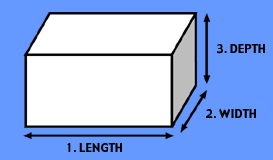Gaming in Three Dimensions
 This article is not about Heroscape, or any other game with a 3-dimensional model for a board. Nor is it about miniatures. It is about choices, and the factors involved in making them. Usually, I make an effort to quantify game properties, but in this case, I will just discuss these 3 areas qualitatively. For lack of better terms, and to go along with my analogy, I'll simply call these 3 dimensions Width, Length, and Depth.
This article is not about Heroscape, or any other game with a 3-dimensional model for a board. Nor is it about miniatures. It is about choices, and the factors involved in making them. Usually, I make an effort to quantify game properties, but in this case, I will just discuss these 3 areas qualitatively. For lack of better terms, and to go along with my analogy, I'll simply call these 3 dimensions Width, Length, and Depth.Width
Width is the number of types of choices or actions you have available to you on your turn. Games with a small Width tend to be less complex, and easier to teach insofar as the rules are concerned. Games with large Width can create Analysis Paralysis as you weigh all the possible options.
Examples of games with small Width: Go (play a stone), Ra (draw tile, invoke Ra), Ticket To Ride (draw cards, build track), Taj Mahal (play card, withdraw), Carcassonne (play tile, then play meeple or not), Through the Desert (play 2 camels).
Examples of games with medium Width: Puerto Rico (choose 1 of 7 roles), Tigris & Euphrates (2 actions: play tile, play catastrophe, move/place/remove leader, draw tiles), Railroad Tycoon (build, urbanize, improve, deliver, take card, western link).
Examples of games with large Width: Struggle of Empires (each tile represents a different action/ability), In the Shadow of the Emperor (each card represents a different action), Reef Encounter (10 possible actions in many different combinations), Maharaja: Palace Building in India (9 possible actions of which each player selects 2), Caylus (placing each worker is, in effect, choosing one of many, many possible actions)
Length
Length is the number of possibilities (eg places to play) you have for a given type of action. In games with more than one type of action, some choices have few possibilities, while others have many. Therefore Length may not be symmetric across the Width. Games with very small Width may still have Analysis Paralysis if one or more of the choices have large Length.
Examples of games with small Length: Antike (all actions expect Maneuver are either automatic or have few options), Puerto Rico (all roles except Builder).
Examples of games with medium Length: Carcassonne (on average, a tile can be placed in a handful of places), El Grande (hand of cards, 5 piles of tiles), Goa (5 tracks to invoke/upgrade), Puerto Rico (Builder).
Examples of games with large Length: Go (play stone anywhere), Tigris & Euphrates (play tile anywhere), Railroad Tycoon (build anywhere), Samurai (play tile(s) anywhere).
Depth
In this case, the word Depth pretty much matches the normal use of the word: the effects and future implications of a choice. Depth also measures how much your choices affect other players, and likewise, how their choices affect you. Even in game situations with only 2 choices (eg a normal turn in Ra), Depth can cause serious consideration; 2 choices with large Depth may be more difficult than 10 choices with small depth. Games with small Depth are tactical; your choice affects the immediate game situation, and little else. Games with large Depth are strategic; your choice affects the entire game. Depth affects how heavy a game feels, as well as how difficult it is to play well.
Depth is the most difficult dimension to discuss in terms of small/medium/large. Even in games as simple as Tic-Tac-Toe, every move affects the entire game. So in this case I am making a judgment call on how much thinking I do when evaluating a given choice. In some cases, pure calculation is being performed, while in others, intuition takes over. Chaos (number of players, and how much the game state will change before it is you turn again) and randomness (cards, dice, drawn tiles) tend to lower Depth (or perception of Depth) because long-range planning is less predictable.
Examples of games with small Depth: Alhambra, Hansa, Carcassonne, China, Ingenious, Niagara, Ticket to Ride.
Examples of games with medium Depth: Ra, Puerto Rico, Euphrates & Tigris, Amun-Re, and the GIPF games.
Examples of games with large Depth: Go, Chess, and perhaps some of the heavier euros like Age of Steam (never played) and Die Macher (played once).
Summary
Of course, all of the above is complicated by the fact that most games have sequences of play. In one phase, you may do something automatically, and in others you may have many complex choices. Choices may be interwoven among players, or even broken down into sub-choices in such a way that you can change your mind on the fly.
Whatever use Width, Length, and Depth are, they are always present for me when evaluating a game. Other than small in all three, I don't think there are any combinations that correlate well to games I like or dislike. It seems that many of top games at BGG have small Length, and medium Width and Depth, which translates to an elegant and somewhat meaty game.
Can you apply these properties to your own tastes?





2 Comments:
Nice article Jim. A very useful model for analyzing games.
I definitely prefer games with greater depth (BTW, I think you missed Princes of Florence as an example), and probably medium width, but not a lot of length.
I left PoF out intentionally since it was more difficult to put into the system because of the 2 very different phases. When I give examples of concepts I am discussing, I try to use more obvious ones.
Post a Comment
<< Home